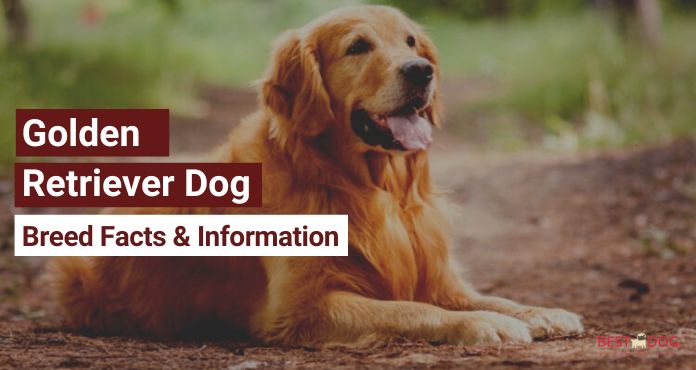The Golden Retriever is one of the most popular dog breeds in the world. These beautiful dogs are family-friendly and easy to train, making them an excellent choice for many families. But what do you need to know about this breed?
In this article, we’ll cover everything from history and care to grooming and exercise needs. We’ll also go over common health problems that Goldens can face, along with diet and nutrition information so you can make sure your dog stays healthy throughout its life.
Breed Overview
Before buying a Golden retriever, do some research to ensure that breed is right for your family.
| Group | Sporting |
| Height | 23 to 24 inches (males); 21.5 to 22.5 inches (females) |
| Weight | 65 to 75 pounds (males); 55 to 65 pounds (females) |
| Coat | Medium-length double coat |
| Coat Color | Light to dark gold |
| Life Span | 10 to 12 years. |
| Temperament | Trustworthy, intelligent, playful, energetic. |
| Hypoallergenic | No |
| Origin | United Kingdom, Scotland |
Characteristics of the Golden Retriever
The temperament of Golden Retrievers is friendly and outgoing. But with proper training, they can be made to have even more energy than usual.
| Affection Level | High |
| Friendliness | High |
| Kid-Friendly | High |
| Pet-Friendly | High |
| Exercise Needs | High |
| Playfulness | High |
| Energy Level | High |
| Trainability | High |
| Intelligence | High |
| Tendency to Bark | Medium |
| Amount of Shedding | High |
History of the Golden Retriever
The Golden Retriever originated in Scotland, where it was developed as a hunting and water retriever. The breed’s name is derived from their coat color; they have a thick, golden-hued coat that makes them ideal for retrieving games.
The American Kennel Club (AKC) recognized the Golden Retriever in 1925 and the Canadian Kennel Club (CKC) in 1931. In addition to being recognized by these organizations, the breed is also recognized by the United Kingdom Kennel Club (UKC).
Golden Retriever Care
Golden Retrievers are a large dog breed, which means that they need to be well-exercised and groomed regularly. They will shed year round but especially when it’s hot out, so brush them at least every other day to prevent tangles and mats from forming.
Bathe them once or twice per month if you live in an area where it gets very hot during the summer months or more often if they get dirty from playing outside.
Grooming
The Golden Retriever’s coat is very easy to groom. Brushing daily will keep it free of dead hair and matting, which can lead to skin problems. In addition, brushing removes dirt and debris that could cause infection or other issues.
The Golden Retriever can be bathed as needed, but not more than once a month. If you choose to bathe your Golden Retriever, use a shampoo designed for dogs rather than one designed for humans–this will reduce the likelihood of allergic reactions or other adverse reactions.
Exercise
Just like humans, Golden Retrievers need to get their daily exercise. They are a fairly active breed and enjoy playing games and running around. If you do not have the time to walk your dog daily, be sure to provide other forms of physical activity. Some suggestions include the following:
- Taking your dog to the park or on a walk in the neighborhood
- Fetching a ball with them (make sure not too big, though)
- Playing tug-of-war or hide-and-seek with them
Training
Training a Golden Retriever is not too difficult. They are eager to please and respond well to positive reinforcement. The Golden Retriever is considered one of the top 10 most intelligent dog breeds, so they are quick learners with a natural ability for obedience training.
The easy-to-train nature of the Golden Retriever makes them excellent family pets for everyone, from children to senior citizens, because it does not take long for these dogs to learn new tricks or commands.
Common Health Problems
- Hip dysplasia is common in which the hip socket does not form properly, allowing the thigh bone to slip out of place.
- According to the American Kennel Club, cancer is the second leading cause of death in Golden Retrievers.
- Pancreatitis can be fatal if untreated and causes severe abdominal pain and vomiting. It is an inflammation of the pancreas that causes it to become enlarged and painful.
- Eye problems include cataracts, glaucoma, corneal ulcers (ulcers on the eye’s surface), and dry eye syndrome (also called keratoconjunctivitis sicca).
- Kidney disease can lead to kidney failure, and many medications that are beneficial for other conditions are harmful to dogs with kidney disease because they have less ability to process them due to their kidneys’ inability -Heart disease affects about 30 percent of Golden Retrievers by age 10 years old; this includes congenital heart defects such as patent ductus arteriosus (PDA), patent foramen ovale(PFO), ventricular septal defect(VSD).
- Thyroid disease occurs when your dog’s thyroid gland overproduces or underproduces hormones that regulate metabolism.
Diet and Nutrition
Feeding your Golden Retriever three meals per day is essential to a healthy diet. They tend to be large dogs, so it’s essential to keep them at a healthy weight. A good rule of thumb is that any food you give should have less than 30 percent protein, as they can easily become overweight with too much protein in their diets.
Some foods are not recommended for Golden Retrievers because of the possibility of allergies or digestive issues. These include chocolate, grapes, and rawhide chews.
Where to Adopt or Buy a Golden Retriever
If you’re looking to adopt a golden retriever, you may be able to find one at a local shelter or rescue group. Many dogs are waiting for homes in these places, and they can help you determine if this dog is suitable for your family based on their history and personality.
- Golden Retriever Rescue Resource
- Golden Retriever Rescue, Education and Training
- Golden Retriever Club of America
Your best bet in terms of finding out what the temperament is like when looking at online ads is asking questions of the people who own the dog or seeing if they have any videos posted online showing their dog interacting with others (like kids).
More Dog Breeds and Further Research
If you’ve made it this far, thanks for reading! You can learn more about other dog breeds here.
We also recommend researching the Golden Retriever’s history, temperament, and health problems. This will help you understand your new pal on a deeper level.
Additionally, we recommend learning about its diet as well as how to care for them properly (e.g., grooming).
FAQ
The average height of an adult male Golden Retriever is 23 to 24 inches tall at the shoulder and weighs 60-80 pounds. The female averages 22 to 23 inches and weighs 55-75 pounds.
The average weight for an adult male Golden Retriever comes between 60-80 pounds and 55-75 pounds for females.
Golden Retrievers generally live 10 years or longer, with some living into their teens!
Conclusion
We hope you enjoyed reading this article about Golden Retriever Dog Breed Facts & Information. If you found this information exciting and want to learn more about dogs, please visit our website for more articles about dog breeds and how to train your dog.












